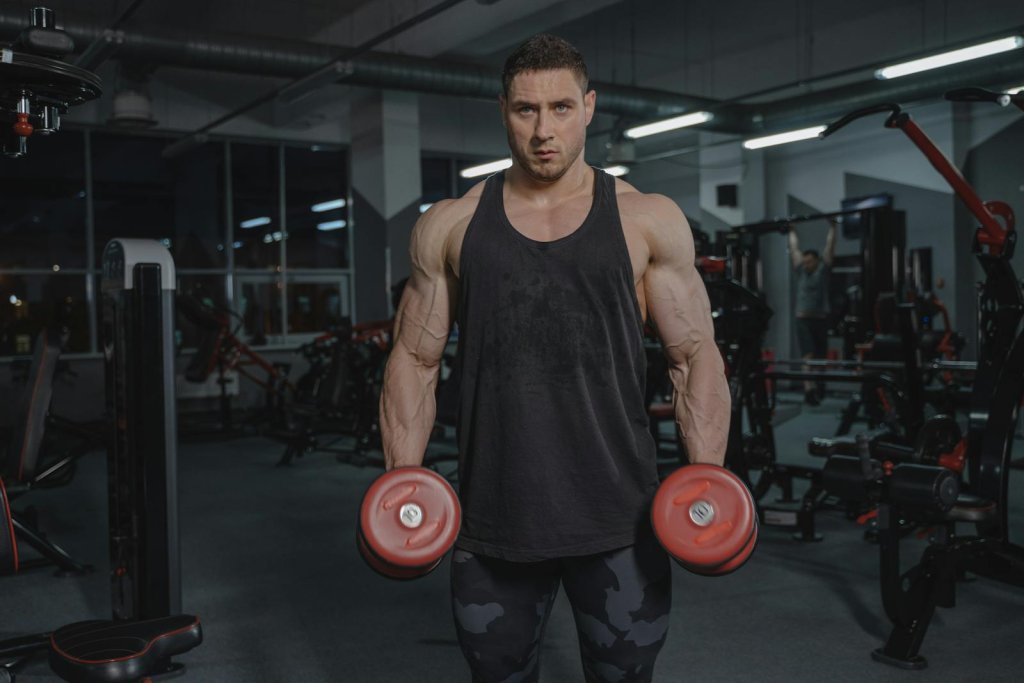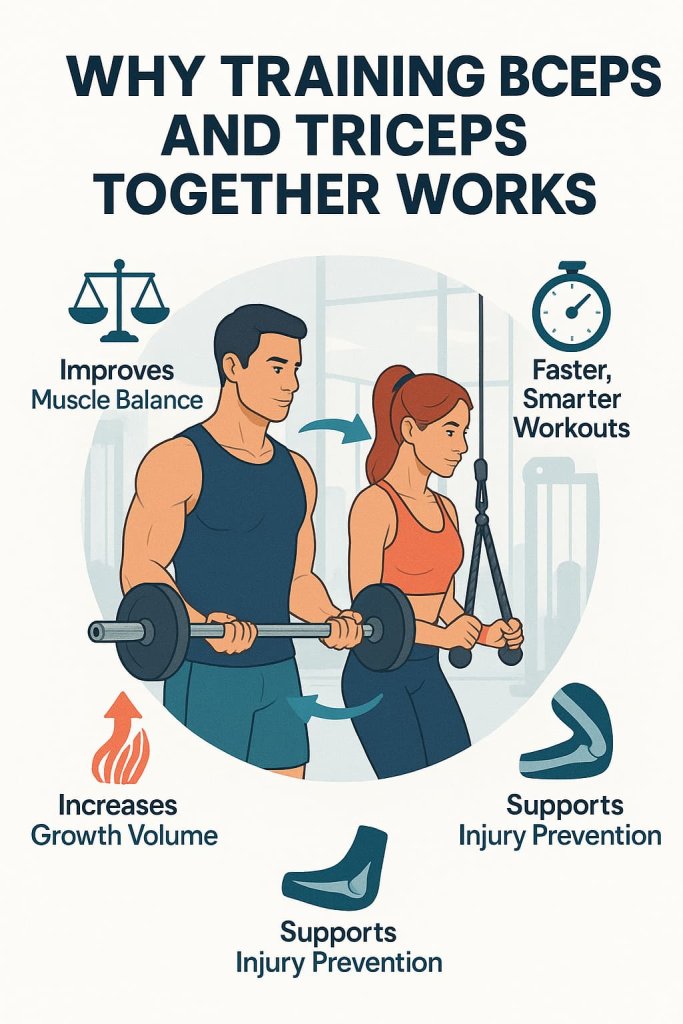The best way to build strong, defined arms is by training your biceps and triceps together. These two muscle groups work in balance — the biceps flex your elbow, while the triceps extend it. Together, they shape your upper arms, enhance performance, and boost overall strength.

Understanding how to target each muscle head properly can transform your arm workouts. This guide covers the 10 best biceps and triceps exercises proven by research to build muscle, improve tone, and increase power — whether you train at home or in the gym.
Why Training Biceps and Triceps Together Works
Training biceps and triceps in one session balances muscle development, prevents imbalances, and supports joint health.
According to the Journal of Strength & Conditioning Research (2024), pairing antagonist muscles (like biceps and triceps) in supersets improves efficiency and increases total training volume — leading to greater hypertrophy.

Benefits include:
- Improved arm symmetry and definition
- Greater strength and endurance
- Faster workouts with better blood flow (antagonistic supersets)
- Reduced injury risk through balanced training
10 Best Biceps and Triceps Exercises for Strong, Defined Arms
These 10 best biceps and triceps exercises combine science-backed movements to help you build strength, size, and definition efficiently.
Whether you train at home or in the gym, these moves target every muscle head for balanced, sculpted arms.
1. Barbell Curl
Why it works:
The barbell curl remains the gold standard for building overall biceps mass. It allows you to progressively overload both biceps heads and increase muscle fiber recruitment for size and strength.
Muscles worked:
Biceps brachii (short and long heads), brachialis, forearms.
How to do it:
- Stand upright holding a barbell with an underhand grip, hands shoulder-width apart.
- Keep elbows tight to your torso and curl the bar toward your upper chest.
- Pause briefly at the top to squeeze the biceps, then slowly lower the bar to the starting position.
Trainer Tip:
Avoid using momentum or swinging your torso — slow, controlled reps maximize tension and growth.
2. Incline Dumbbell Curl
Why it works:
The incline position stretches the biceps long head under tension, activating deep muscle fibers for greater hypertrophy and shape.
Muscles worked:
Biceps brachii (long head), brachialis, forearms.
How to do it:
- Sit on an incline bench set at about 45°.
- Let your arms hang straight down, palms facing forward.
- Curl the dumbbells up while keeping your elbows stationary, then lower them under control.
Trainer Tip:
Lower the weight slowly — emphasizing the eccentric (lowering) phase enhances muscle growth.
3. Hammer Curl
Why it works:
This variation shifts focus to the brachialis and brachioradialis, building arm thickness and functional grip strength.
Muscles worked:
Biceps brachii, brachialis, brachioradialis.
How to do it:
- Stand tall with a dumbbell in each hand, palms facing each other.
- Curl the weights up until your forearms are vertical.
- Lower back down under full control.
Trainer Tip:
Keep your wrists in a neutral position throughout to protect joints and engage forearms.
4. Concentration Curl
Why it works:
By isolating one arm at a time, this move maximizes focus and contraction, minimizing shoulder assistance.
Muscles worked:
Biceps brachii (short head).
How to do it:
- Sit on a bench, holding a dumbbell in one hand.
- Rest your elbow on your inner thigh.
- Curl the dumbbell toward your shoulder, squeezing the biceps at the top.
- Slowly lower to the start.
Trainer Tip:
Keep your upper arm still and focus on squeezing the muscle — this builds both strength and definition.
5. Chin-Up (Underhand Grip)
Why it works:
A compound exercise that challenges multiple upper-body muscles while producing high biceps activation.
Muscles worked:
Biceps brachii, latissimus dorsi, forearms, shoulders.
How to do it:
- Grab a pull-up bar with an underhand grip, hands shoulder-width apart.
- Pull your body up until your chin clears the bar.
- Lower slowly under full control.
Trainer Tip:
Keep your body stable and avoid kipping — strict reps create more muscle engagement.
6. Close-Grip Bench Press
Why it works:
This compound triceps movement allows heavier loading and strengthens all three triceps heads while also recruiting the chest and shoulders.
Muscles worked:
Triceps brachii (long, lateral, and medial heads), chest, shoulders.
How to do it:
- Lie flat on a bench with a narrow grip (just inside shoulder width).
- Lower the bar to your lower chest while keeping elbows close to your torso.
- Press upward until arms are fully extended.
Trainer Tip:
Do not flare your elbows — maintain a tucked position to protect shoulders and isolate triceps.
7. Overhead Triceps Extension (Dumbbell or Cable)
Why it works:
This movement emphasizes the long head of the triceps, which contributes most to overall arm size.
Muscles worked:
Triceps brachii (long head).
How to do it:
- Sit or stand holding a single dumbbell with both hands overhead.
- Lower the weight behind your head in a controlled motion.
- Extend your arms back to the starting position.
Trainer Tip:
Keep elbows pointed forward and close to your ears to maintain tension on the triceps.
8. Triceps Pushdown (Cable or Band)
Why it works:
This isolation exercise provides constant resistance and effectively targets the lateral and medial triceps heads.
Muscles worked:
Triceps brachii (lateral and medial heads).
How to do it:
- Stand facing a cable station or resistance band.
- Grip the attachment with palms down or using a rope.
- Push down until arms are fully straightened, then slowly return to the start.
Trainer Tip:
Keep your torso upright and elbows pinned to your sides for maximum muscle isolation.
9. Bench Dips
Why it works:
A powerful bodyweight move that hits the triceps, chest, and shoulders, great for building arm definition and strength.
Muscles worked:
Triceps, anterior deltoids, chest.
How to do it:
- Sit on a bench and place your hands beside your hips.
- Slide forward so your hips are off the bench.
- Lower yourself until your elbows reach 90°, then press back up.
Trainer Tip:
Add a second bench or weight plate on your lap for progressive overload as you get stronger.
10. Diamond Push-Up
Why it works:
A bodyweight classic that emphasizes triceps engagement while strengthening the chest and core.
Muscles worked:
Triceps, chest, shoulders, core.
How to do it:
- Assume a push-up position and place your hands together to form a diamond under your chest.
- Lower your body until your chest nearly touches your hands.
- Push back up while keeping elbows tight to your sides.
Trainer Tip:
Maintain a straight line from head to heels — proper form ensures full triceps engagement.
How to Structure Your Arm Workout
- Weekly Frequency: 2–3 sessions
- Sets & Reps: 3–4 sets × 8–12 reps per exercise
- Rest Between Sets: 45–60 seconds
- Progression: Gradually increase weight or reps every 2–3 weeks
- Rest Days: 48 hours between arm sessions for recovery
Sample Split Example:
- Day 1: Biceps focus (curls, chin-ups, hammer curls)
- Day 2: Rest or lower body
- Day 3: Triceps focus (close-grip bench, extensions, pushdowns)
Safety Tips Before You Start
- Warm up for 5–10 minutes with light cardio and dynamic stretches.
- Use proper form before increasing load.
- Keep wrists and shoulders aligned during pressing movements.
- Breathe steadily — exhale during exertion.
- Stop immediately if you feel joint or tendon pain.
Common Mistakes to Avoid in Arm Training
- Lifting too heavy: Hurts form and limits muscle tension.
- Partial reps: Use full range of motion for best results.
- Overtraining biceps: Triceps form two-thirds of your arm — train both evenly.
- No progression: Gradually increase weight or reps every few weeks.
- Skipping warm-up: Always do 5–10 minutes of mobility prep.
Trainer Tip: Film your form or get feedback to fix posture and prevent injury.
Nutrition Tips for Arm Growth
- Eat enough protein: 1.6–2.2 g per kg body weight.
- Stay in a small calorie surplus: 5–10% above maintenance for lean muscle gain.
- Choose whole foods: Lean proteins, complex carbs, healthy fats.
- Hydrate well: 2.5–3 L water daily.
- Recover smart: Eat protein + carbs within 30–60 min post-workout.
Trainer Tip: Track progress weekly — consistency drives arm growth.
FAQ
1. Can I train biceps and triceps on the same day?
Yes. Training antagonist muscles together improves balance, efficiency, and pump.
2. How often should I do arm workouts?
2–3 times weekly with at least one rest day between sessions.
3. Should I lift heavy or light weights for arms?
Both. Heavy loads (6–8 reps) build strength; moderate loads (10–12 reps) enhance muscle definition.
4. How long before I see results?
With consistent training and nutrition, noticeable definition can appear in 4–6 weeks.
5. Do I need gym equipment for arm growth?
No. Bodyweight moves like diamond push-ups and dips still effectively build strength and tone.
6. What’s the best rep range for muscle gain?
Research supports 6–12 reps with progressive overload for optimal hypertrophy.
7. Should I stretch after arm workouts?
Yes. Stretching aids recovery and improves flexibility.
Conclusion
Stronger, more defined arms come from smart, consistent training — not just endless curls. By combining these 10 best biceps and triceps exercises, maintaining good form, and progressing gradually, you’ll build arms that look powerful and perform even better.
Start today — track your sets, stay consistent, and watch your arms transform week by week.
References
- Triceps long-head grows more with overhead extensions (vs. neutral/pushdown positions) — 12-week within-subject trial.
Triceps brachii hypertrophy is substantially greater after elbow extension training performed in the overhead versus neutral arm position (Maeo et al., 2023, Eur J Sport Sci) - Chin-ups produce higher biceps activation than pull-ups — supports including chin-ups in “Top 10.”
Surface electromyographic activation patterns… during chin-up vs. pull-up (Youdas et al., 2010, J Strength Cond Res) - EZ-bar curl shows the highest overall biceps/brachioradialis EMG among curl variants — great for exercise selection.
Differences in electromyographic activity of biceps brachii and brachioradialis during four variants of curl (Marcolin et al., 2018, PeerJ) - Training volume for hypertrophy — systematic review comparing moderate vs. high weekly sets; informs your sets/week guidance.
A Systematic Review of the Effects of Different Resistance Training Volumes on Muscle Hypertrophy (Baz-Valle et al., 2022) - Protein intake for muscle gain — meta-analysis shows gains plateau ~1.6 g/kg/day; underpins your nutrition tips.
A systematic review, meta-analysis and meta-regression of protein supplementation and resistance training (Morton et al., 2018, Br J Sports Med)
